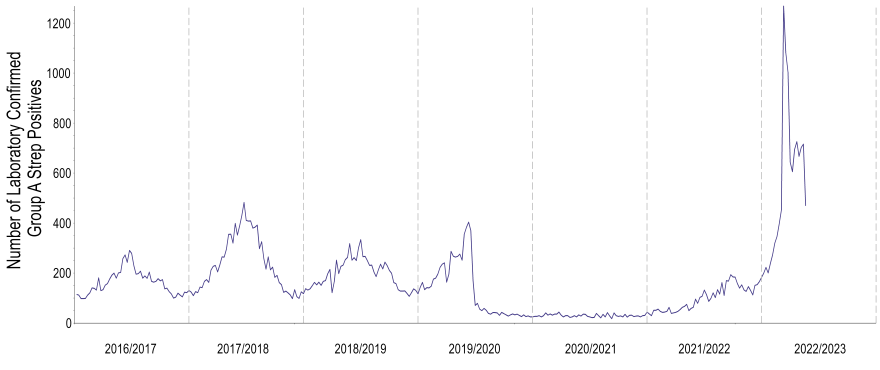References
- Sims Sanyahumbi A, Colquhoun S, Wyber R, et al. Global Disease Burden of Group A Streptococcus. In: Ferretti JJ, Stevens DL, Fischetti VA, eds. Streptococcus pyogenes: Basic Biology to Clinical Manifestations. Oklahoma City (OK): University of Oklahoma Health Sciences Center© The University of Oklahoma Health Sciences Center. 2016.
- Carapetis JR, Steer AC, Mulholland EK, et al. The global burden of group A streptococcal diseases. The Lancet Infectious Diseases 2005;5(11):685-94.
- McNeil JC, Flores AR, Kaplan SL, et al. The Indirect Impact of the SARS-CoV-2 Pandemic on Invasive Group a Streptococcus, Streptococcus Pneumoniae and Staphylococcus Aureus Infections in Houston Area Children. Pediatr Infect Dis J 2021;40(8):e313-e16. doi: 10.1097/inf.0000000000003195 [published Online First: 2021/07/13]
- World Health Organization. Increased incidence of scarlet fever and invasive Group A Streptococcus infection - multi-country 2023 [Available from: https://www.who.int/emergencies/disease-outbreak-news/item/2022-DON429 accessed 22/02 2023.
- Centres for Disease Control and Prevention. Increase in Invasive Group A Strep Infections, 2022–2023 2023 [Available from: https://www.cdc.gov/groupastrep/igas-infections-investigation.html accessed 9th March 2023.
- van Kempen EB, Bruijning-Verhagen PCJ, Borensztajn D, et al. Increase in invasive group A streptooccal infections in children in the Neatherlands, a survey among 7 hospitals in 2022. The Pediatric Infectious Disease Journal 9900:10.1097/INF.0000000000003810. doi: 10.1097/inf.0000000000003810
- Guy R, Henderson KL, Coelho J, et al. Increase in invasive group A streptococcal infection notifications, England, 2022. Euro Surveill 2023;28(1) doi: 10.2807/1560-7917.Es.2023.28.1.2200942 [published Online First: 2023/01/26]
- Victoria Department of Health. Health warning on invasive group A streptococcal disease: Victoria Department of Health; 2022 [Available from: https://www.health.vic.gov.au/health-advisories/health-warning-on-invasive-group-a-streptococcal-disease2023.
- Guy R, Henderson KL, Coelho J, et al. Increase in invasive group A streptococcal infection notifications, England, 2022. Eurosurveillance 2023;28(1):2200942. doi: doi:https://doi.org/10.2807/1560-7917.ES.2023.28.1.2200942
- Williamson DA, Morgan J, Hope V, et al. Increasing incidence of invasive group A streptococcus disease in New Zealand, 2002-2012: a national population-based study. J Infect 2015;70(2):127-34. doi: 10.1016/j.jinf.2014.09.001 [published Online First: 2014/09/24]
- Institute of Environmental and Scientific Research (ESR). Invasive group A streptococcal infection in New Zealand, 2016, 2017.
- Cannon JW, Zhung J, Bennett J, et al. The economic and health burdens of diseases caused by group A Streptococcus in New Zealand. Int J Infect Dis 2021;103:176-81. doi: 10.1016/j.ijid.2020.11.193 [published Online First: 2020/12/06]
- Thomas S, Bennett J, Jack S, Oliver J, Purdie G, Upton A, Baker MG. Descriptive analysis of group A Streptococcus in skin swabs and acute rheumatic fever, Auckland, New Zealand, 2010–2016. The Lancet Regional Health - Western Pacific 2021;8
- Bennett J, Zhang J, Leung W, et al. Rising Ethnic Inequalities in Acute Rheumatic Fever and Rheumatic Heart Disease, New Zealand, 2000-2018. Emerg Infect Dis 2021;27(1):36-46. doi: 10.3201/eid2701.191791 [published Online First: 2020/12/23]
- Williamson DA, Moreland NJ, Jack S. Invasive Group A Streptococcal Infections in Indigenous New Zealanders With Type 2 Diabetes. Clinical Infectious Diseases 2016;63(9):1268-69. doi: 10.1093/cid/ciw420
- Safar A, Lennon D, Stewart J, et al. Invasive group A streptococcal infection and vaccine implications, Auckland, New Zealand. Emerg Infect Dis 2011;17(6):983-9. doi: 10.3201/eid/1706.100804 [published Online First: 2011/07/14]
- Oliver J, Thielemans E, McMinn A, et al. Invasive group A Streptococcus disease in Australian children: 2016 to 2018 – a descriptive cohort study. BMC Public Health 2019;19(1):1750. doi: 10.1186/s12889-019-8085-2
- Jeffrey D. What is strep A, the potentially deadly disease that has Australian health authorities on high alert? Australia: 9 News, 2023.
- Davies MR, Keller N, Brouwer S, et al. Detection of Streptococcus pyogenes M1UK in Australia and characterization of the mutation driving enhanced expression of superantigen SpeA. Nature Communications 2023;14(1):1051. doi: 10.1038/s41467-023-36717-4
- New Zealand Government. Funding for vaccine development to help prevent rheumatic fever 2021 [Available from: https://www.beehive.govt.nz/release/funding-vaccine-development-help-prevent-rheumatic-fever accessed 9th March 2023.
- Baker MG Gurbey J, Moreland NJ, Bennett J, Oliver J, Williamson DA, Pierse N, Wilson N, Merriman TR, Percival T, Jackson C, Edwards R, Chan Mow F, Thompson WM, Zhang J, Lennon D. Risk factors for acute rheumatic fever: a case-control study. Lancet Reg Health West Pac 2022;Sep 1;26
- Bennett J, Moreland NJ, Zhang J, et al. Risk factors for group A streptococcal pharyngitis and skin infections: A case control study. The Lancet Regional Health - Western Pacific 2022;26:100507. doi: https://doi.org/10.1016/j.lanwpc.2022.100507
- Das DK, Baker MG, Venugopal K. Increasing incidence of necrotizing fasciitis in New Zealand: a nationwide study over the period 1990 to 2006. J Infect 2011;63(6):429-33. doi: 10.1016/j.jinf.2011.07.019 [published Online First: 2011/08/26]
- Steer AC, Lamagni T, Curtis N, et al. Invasive group a streptococcal disease: epidemiology, pathogenesis and management. Drugs 2012;72(9):1213-27. doi: 10.2165/11634180-000000000-00000 [published Online First: 2012/06/13]
- Cordery R, Purba AK, Begum L, et al. Frequency of transmission, asymptomatic shedding, and airborne spread of Streptococcus pyogenes in schoolchildren exposed to scarlet fever: a prospective, longitudinal, multicohort, molecular epidemiological, contact-tracing study in England, UK. Lancet Microbe 2022;3(5):e366-e75. doi: 10.1016/s2666-5247(21)00332-3 [published Online First: 2022/05/12]
- Brouwer S, Rivera-Hernandez T, Curren BF, et al. Pathogenesis, epidemiology and control of Group A Streptococcus infection. Nature Reviews Microbiology 2023 doi: 10.1038/s41579-023-00865-7
About the Briefing
Public health expert commentary and analysis on the challenges facing Aotearoa New Zealand and evidence-based solutions.
Subscribe

Public Health Expert Briefing
Get the latest insights from the public health research community delivered straight to your inbox for free. Subscribe to stay up to date with the latest research, analysis and commentary from the Public Health Expert Briefing.

